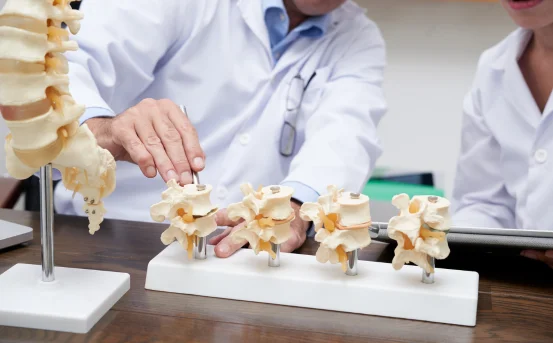Introduction
Spinal surgery is a specialized medical procedure performed to treat various conditions affecting the spine. The spine is a complex structure made up of bones, discs, nerves, and muscles, all working together to support movement and protect the spinal cord. When injury, deformity, or disease impairs these functions, surgical intervention may become necessary. Common indications for spinal surgery include herniated discs, spinal stenosis, scoliosis, fractures, tumors, and degenerative disc disease. The goal of spinal surgery is to relieve pain, restore function, and prevent further neurological damage. Due to advances in medical technology, types of spinal surgery have emerged, each tailored to specific spinal conditions and patient needs. Understanding Types of Spinal Surgery is essential for patients considering these procedures.
Types of Spinal Surgery
- Discectomy :- Discectomy is a commonly performed spinal surgery that involves removing the portion of a herniated disc that presses on a spinal nerve. The goal is to relieve symptoms like back or leg pain, numbness, and muscle weakness. The surgery can be performed using open or minimally invasive techniques depending on the severity and location of the herniation.
- Laminectomy :- Laminectomy involves the surgical removal of the lamina, the back part of the vertebra covering the spinal canal. It is often recommended for patients with spinal stenosis, where narrowing of the spinal canal causes nerve compression. By removing the lamina, pressure on the spinal cord and nerves is relieved, helping improve mobility and reduce pain.
- Spinal Fusion :- Spinal fusion is a procedure to permanently join two or more vertebrae. It is used in conditions such as spinal instability, scoliosis, fractures, or degenerative disc disease. The fusion eliminates motion between the affected vertebrae, reducing pain and preventing further spinal deterioration. Surgeons may use bone grafts, screws, rods, or cages to support the fusion process.
- Foraminotomy :- Foraminotomy is performed to widen the foramen the openings where spinal nerves exit the spinal column. Narrowing of these passageways can lead to nerve compression, causing pain and weakness. By removing bone or tissue obstructing the foramen, this procedure relieves pressure and improves nerve function.
- Disc Replacement Surgery :- Also known as artificial disc replacement, this surgery involves removing a damaged disc and replacing it with a synthetic one. It’s typically performed in the cervical or lumbar spine and offers an advantage over fusion by maintaining spinal flexibility. It’s a preferred option for some patients with severe disc degeneration who have not improved with conservative treatment.
- Kyphoplasty and Vertebroplasty :- These are minimally invasive procedures used to treat compression fractures, often resulting from osteoporosis. Vertebroplasty involves injecting bone cement directly into the fractured vertebra for stability. In kyphoplasty, a balloon is first inflated to restore vertebral height before the cement is inserted. Both techniques help relieve pain and improve spinal function.
- Scoliosis Surgery :- Scoliosis surgery is aimed at correcting abnormal curvature of the spine in adolescents and adults. Using rods, screws, and bone grafts, the spine is straightened and stabilized. This procedure helps prevent the progression of the curve and alleviates symptoms like back pain and breathing issues in severe cases.
- Minimally Invasive Spinal Surgery (MISS) :- MISS encompasses a range of spinal procedures performed through small incisions using specialized instruments and imaging. It includes minimally invasive discectomy, fusion, or decompression. These techniques offer benefits such as reduced blood loss, less postoperative pain, and faster recovery times compared to traditional open surgery.
- Spinal Tumor Removal Surgery :- Surgery for spinal tumors is done to remove benign or malignant growths affecting the spinal cord, nerve roots, or vertebrae. The goal is to reduce symptoms like pain and neurological deficits. Depending on the tumor’s location and type, partial or complete removal may be followed by spinal stabilization or adjunct treatments like radiation or chemotherapy.
- Coccygectomy :- Coccygectomy involves the surgical removal of the tailbone (coccyx). It is considered when chronic tailbone pain (coccydynia) does not improve with non-surgical treatments. This procedure can help relieve persistent discomfort caused by trauma, inflammation, or abnormal bony growths in the coccyx.
- Anterior Cervical Discectomy and Fusion (ACDF) :- ACDF is a widely performed neck surgery where a damaged cervical disc is removed via an incision in the front of the neck. A bone graft or implant is placed in the empty disc space, and the vertebrae are fused together. This surgery is highly effective in treating nerve or spinal cord compression in the neck, reducing symptoms such as neck pain, arm pain, tingling, or weakness.
Conclusion
Spinal surgery encompasses a wide range of procedures, each designed to address specific structural or functional problems within the spine. From relatively straightforward procedures like discectomy and laminectomy to more complex operations such as spinal fusion, scoliosis correction, or tumor removal, these surgeries offer critical solutions for patients suffering from pain, disability, or neurological compromise. The type of spinal surgery recommended depends on several factors, including the nature and severity of the condition, the patient’s overall health, and their long-term goals. Technological advancements continue to improve the safety and outcomes of spinal surgeries, with minimally invasive techniques becoming increasingly favored. As with any major medical procedure, spinal surgery requires careful evaluation, thorough diagnosis, and a personalized approach to ensure the best possible results for each patient.























